The Estonian town of Sillamäe is a showpiece example of grand Stalinist architecture — but according to Soviet maps, the settlement never even existed.
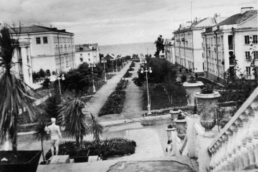
1947 would have been a strange year for students graduating school in the central Russian town of Kineshma.
The fresh-faced class, who would have been around 18 at the time, were herded onto a train — the type usually reserved for cattle — without a word about where they were headed.
Anyone familiar with Soviet history might already be predicting where this tale might be going — but these students were going to a place far better than where they had come from.
At least that’s according to Sillamäe native and local historian Yelena, whose grandparents embarked on one such journey.
But before we get to why these kids were made to embark on such a trip — let’s take a look at the history of the highly-classified destination to which they were headed some 1000 km away.
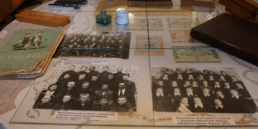
Sillamäe — a brief history
Before WWII, there was little to be found in Sillamäe and the surrounding area. Finnish-Hungarian farmers had initially set up camp there around the end of the 19th century. Shortly afterwards, a Swedish industrialist discovered that shale oil could be extracted from the land and set up a factory.
Since it’s only 25km from the Russian border, Sillamäe became popular with aristocratic figures such as Tchaikovsky and Stravinsky who would holiday there, basking in the fresh breeze of the Baltic Sea.
Nobel prize-winning scientist Ivan Pavlov frequented the place for several decades. According to Yelena, when he was collecting a prize in Italy, he even bemoaned in a letter to his wife that he much preferred Sillamäe to Venice — which may surprise some, considering there was wasn’t much there at the time.
Alas, the Russian Revolution put an end to these aristocratic sojourns, and the Red Army took over the land, and with it, the oil factory. The Soviets nationalised the factory, and oddly enough, there are records of them selling oil from Sillamäe to power German submarines right up until the eve of World War II.
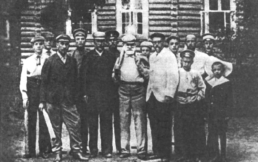
It was during the war that the town became a strategic stronghold. Since it was next to the sea, close to Russia, and surrounded by three fort-like hills, it was the scene of many a battle.
Yelena says that today, volunteers regularly go out into Sillamäe’s forests, searching for the bodies of Soviet and Nazi soldiers, of which apparently, there are still plenty.
The volunteers dig up their remains, identify them and send their details to their relatives. It’s hard not to wonder what kind of people would embark on such a task — “they don’t receive any money from the government”, Yelena divulged, as if this might help fill in any blanks.
After the war ended, the Soviets reclaimed control of the area and turned themselves to rebuilding its infrastructure. But it wasn’t only Sillamäe’s shale oil factory that they reconceived. They would go on to take the town in an entirely different direction — or rather, they took it beyond the point of navigation, and wiped it off the map altogether.
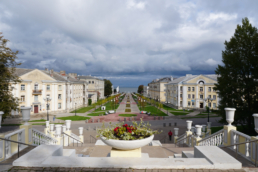
The Beginning of Non-Existence
Following 1945, the urgency of the nuclear arms race led Stalin to send geologists all over the Soviet Union to scout out potential places where they could mine ore for uranium enrichment.
In Sillamäe, they came across Dictyonema, one such type of ore. Upon further inspection, it turned out to be ideal for the Soviets’ purposes, as in this area in particular, it was very close to the earth’s surface and therefore easy to extract.
Stalin and the Director of the Soviet Nuclear Program Laventry Beria soon signed an order declaring the area a militarised zone, and closed it off to the general public. All of the local Estonians were then promptly made to leave.
According to Yelena, “there was no trust on either side. Many of the Estonians had at some point fought against them and the Soviets didn’t trust that their activities there would be kept safe from public knowledge”.
During this Cold War period, Sillamäe was so top-secret that even acknowledging its existence could land you in grave trouble.
In letters, which would always be censored, Sillamäe ’s name or any activities that went on there could not be mentioned at all. All correspondences has to be addressed to the town’s alias postcodes, such as ‘Leningrad 1’ and ‘Narva 2’.
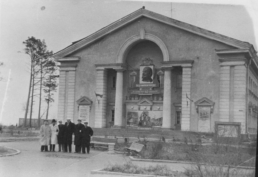
Mass Importation
With the locals booted out, in 1946, Stalin imported 5,000 GULAG prisoners to build the chemical factory complex. After the factory had been built, the place needed workers, which brings us back to the students from Kineshma.
Locals and GULAG workers could not be hired as they could not be trusted or did not possess the required degree of education. To solve this predicament, freshly-graduated students, mostly from Soviet Russia, were transported directly to the town.
With famine rife throughout Russia and shortages abundant, getting secretly sent off to work in a nuclear town that didn’t exist might not have been the worst post-graduate option.
“The villages in Russia were not a pretty sight after the war, and it was hard to get hold of any products. But in Sillamäe, as everything was top secret and important in the nuclear arms race, the standard of life here was good. The wages were high, and supplies were sent straight from Moscow, which meant that the shelves were full and they could even get things like this”, Yelena explains, gesturing to a gift set of ‘Red Moscow’ perfume.
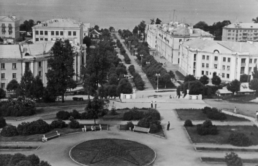
A Model Town
This higher standard of living was not only implemented in the goods on display, but in the city planning itself. In addition to the GULAG prisoners, a further 3,000 ‘Baltic’ Prisoners of War were brought in to build the infrastructure.
Since many prestigious scientists from around the Soviet Union were being invited to Sillamäe, Stalin decided to make the place as comfortable and attractive as possible.
Architects were commissioned to create the centre in Stalin’s socialist classical style. Sillamäe’s House of Culture retains many of its original features, with grand marble pillars, opulent chandeliers, and Renaissance-style ‘coffer’ ceilings with sunken panels.
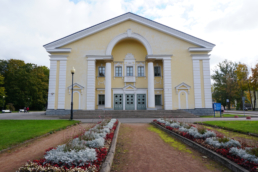
The town serves as an interesting example of how grand Stalinist architecture can be executed on a ‘human’ scale, as opposed to the larger monumental projects erected in big cities like Moscow and Berlin. Flanked by immaculately-kept flower beds, a mini-version of Odessa’s iconic Potemkin steps look out onto the Baltic Sea.
The boulevard that leads down to the promenade is lined with regal houses that are embossed with intricate hammer-and-sickles, as well as nautical-themed details such as shells.
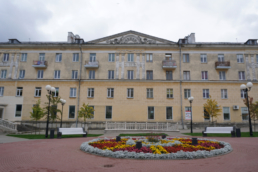
Peculiarly enough, the town hall was built in the style of a Lutherian church – a strange choice for an atheist state. According to the architects, the idea was to create an aesthetic familiar to a medieval-style Old Town, to remain in-keeping with the traditional style of Northern European and Baltic urban planning. In retrospect, it seems a questionable concept, considering that the place was closed off to the outside world with no European or Baltic natives (save for the prisoners), living there.
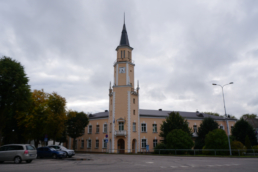
The architecture and town planning earned such prestige that in 1949 the town received an award – the ‘First Prize in Architecture from the Estonian Soviet Socialist Republic. Again, it is intriguing to think how such an award was granted to a town that didn’t exist.
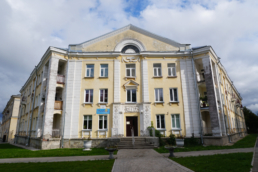
Nuclear Fall Out
Over the five decades of Sillamäe’s (non) existence, some 100,000 tons of uranium were enriched there. They were used to create 70,000 nuclear weapons, including the Soviet Union’s very first nuclear bomb.
After a decade of using locally mined Dictyonema, Sillamäe switched to imported concentrated uranium derived from richer ores. Meanwhile metal and chemical plants were opened, and a factory that produced gas masks to distribute to citizens in the case of a nuclear attack.
But as the USSR began to crumble, so did the productivity and prestige of Sillamäe. After the fall of the Iron Curtain, things took a turn for good. For the first time in decades, the town was reopened to the public.
“After the Soviet Union fell, the Russians took everything with them, all of the technology, valuable machines, and of course the scientists left immediately,” Yelena tells me.
“But what they did leave behind was a whole lot of radioactive waste”.
This ‘whole lot’ amounted to some 12 million tonnes.
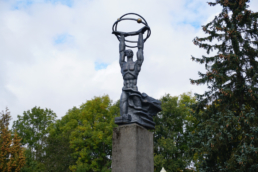
A Radioactive Lake
In the early days of Sillamäe’s ore extraction, the residue left over from the Dictyonema shale, was dumped directly into the sea. Years later, vast amounts of ore that ended up in the form of waste rock, were thoughtfully dumped into a designated waste depository instead.
Open air, the toxic waste formed a highly-radioactive ‘uranium lake’. Since the dams that separated it from the coast were only made from sand, the residue would regularly seep out into the already contaminated sea. It’s also worth noting that the depository was located just 500 metres from the factory, and a kilometre from the residential Old Town where 3,000 residents lived.
The impact was critical — and left to its own devices much longer, the radioactive lake could have potentially poisoned the Eastern part of the Baltic Sea, causing an ecological catastrophe on the scale of Chernobyl.
“The EU spent a lot of money on helping to clear it up. The whole thing was just stewing in the open — completely radioactive,” says Yelena. Reports even surfaced claiming that local children were losing their hair.
Today, if you look out to the sea from the main promenade and glance to the left, next to the factory, a huge mound covers the lake which forms a kind of hill.
“Every year the mayor comes out and hosts a picnic on the hill”, says Yelena enthusiastically.
“They get musicians to play there and invite politicians and do a test on the radiation detector to prove that the whole place is safe. In fact, the last time they did it, the air was more radioactive in the city than on top of that thing!”
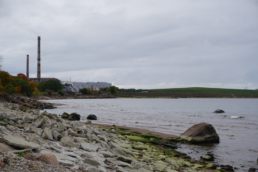
Nothing Left to Hide
Today, if you look around town, most of the signs are bilingual, from the street names to the graffiti (standing testament- I found LOL translated into Cyrillic on Stalin’s showpiece boulevard). However, according to Yelena, almost no one in Sillamäe speaks Estonian.
“Only three per cent here are ethnically Estonian, and everyone just speaks Russian. There is one Estonian-speaking school, but it’s only Russians who send them there. Sometimes they want their kids to speak the language as they believe it will give them the opportunity to earn higher wages,” she says.
Even though some residents may move on to better opportunities in St Petersburg and Tallinn, the town has been trying to shed its toxic image and attract foreign investors.
To incentivise business, it has branded itself as a ‘free zone’ with 0% taxes and duties.
Such deals have attracted the likes of US company Molycorp, who have taken over the metallurgical plant, exporting tantalum and niobium to markets in America and Europe.
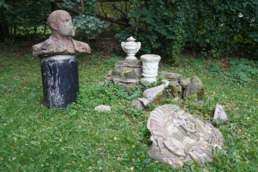
Looking out onto the landscape from the ‘Odessa’ steps, pristine flower beds pave the way to the Baltic Sea and the sun bounces off the proud white facades of the neoclassical buildings.
Little can be heard other than the breeze of the sea, and the streets are completely empty.
It is strange that such a quaint sleepy town was born out of the nuclear arms race, created using mass-scale prison labour, and shrouded in secrecy for so many years.
But it is perhaps the very secrecy in which Sillamäe was shrouded, that lends it this unassuming nature. And maybe, if the Kineshma graduates of ‘47 could see the site today, they wouldn’t be so surprised that a town which was moulded by the strictest of discretions, remains off the radar seven decades on.